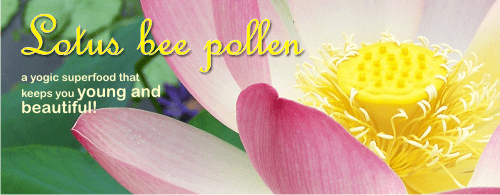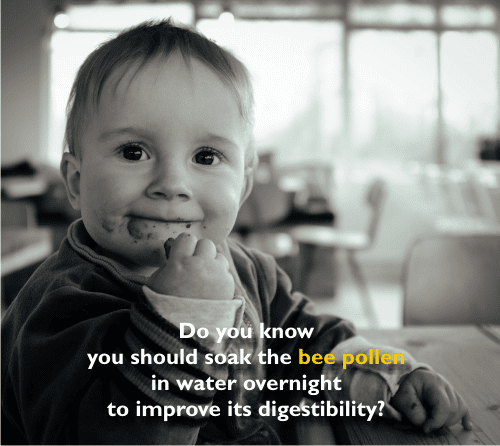Willow bee pollen is a natural ally for better circulation and steady energy, plus nutrients that help maintain overall vitality. It’s rich in heart-friendly compounds and antioxidants that make it a simple part of your daily routine. And the list of benefits doesn’t stop there—from digestive support to an immune boost.
Willow bee pollen is one food that improves blood circulation, fights prostate cancer, and is very nutritious. And the list doesn’t stop here.
Willows do not produce high amounts of nectar, so the bees cannot make much honey, but they are a valuable source of pollen. And honey bees appreciate that.
These days, nutritionists say bee pollen is the most nutritious food we can eat! This study also tells us that bee pollen is vitaminic and contains antioxidant and anti-inflammatory plant phenolics, as well as antiatherosclerotic, antidiabetic, and hypoglycemic flavonoids, unsaturated fatty acids, and sterols.
For the old Egyptians, pollen was “the life-giving dust”!
What is bee pollen?
Not simple flower pollen, which is the male seed of the flower blossom, but a final product made from this flower pollen.
Whenever a honey bee lands on a flower’s blossom, it touches the stamen, and its body gets covered in pollen dust. To clean itself from it, the bee uses its hind legs to compress the pollen into little pollen baskets. It moistens the pollen with secretion from its mouth, which makes the pollen cling together and transports it to the hive. The pollen is removed from the rear legs by a spike on the mid legs and placed in cells. Honey is added to maintain pollen quality.
This is going to be an important source of nutritious food for the hive. And for centuries, for humans as well. Read more on what is bee pollen and which are its health benefits.
Beekeepers harvest the bee pollen by placing some traps inside the hive, and when honey bees arrive, some of their loads of pollen fall on these traps. So basically, bee pollen is flower pollen mixed with bees’ saliva. 🙂
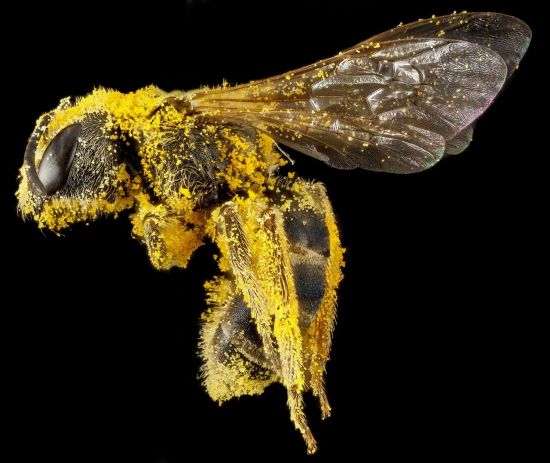
The consumption of pollen, the plant producing seed, is praised in the Bible, Genesis 1:29:
And God said, See, I have given you every plant producing seed, on the face of all the earth, and every tree which has fruit producing seed: they will be for your food.
The willow tree
Everybody knows willow trees. And everybody knows what aspirin is. Though probably not everyone knows that aspirin is made out of willow bark. Willow is indeed a medicinal plant.
Latin name: Salix spp, which has around 400 species.
Other names: sallows, osiers (for some narrow-leaved shrubs)
Willows are deciduous and rapidly growing trees. The leaves are alternate and long with short stems. They generally grow along rivers and prefer moist soil. They are usually insect-pollinated and occasionally wind-pollinated. The appearance of the trees is quite distinct in that their branches hang down in a drooping fashion, commonly down to the ground.
The flowers: Willows have male and female flowers appearing as catkins on separate plants, which are produced early in the spring, often before the leaves.
Willow grains are prolate and subprolate; the amb subtriangular and 3-colporate. The colpi are long and narrow, with tapering ends. Pollen grains are 28-34 X 20-21 micrometers. (According to pollen.com)
The allergenicity of willow is moderate.
Although willows elicit strong allergic responses from individuals in allergy tests, willows tend to be pollinated more by insects than by wind and therefore present fewer people with the allergenic challenge than other tree types.
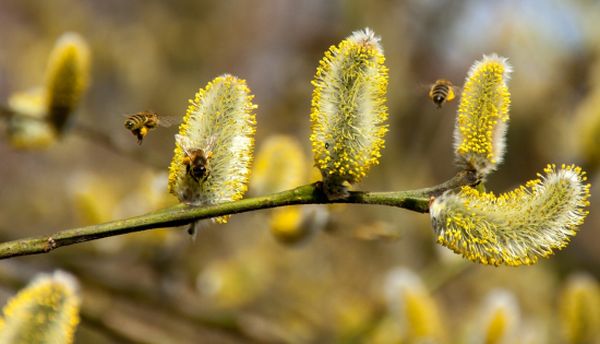 willow catkins with honey bees – picture source pixabay.com
willow catkins with honey bees – picture source pixabay.com
Willow is preferred by picky bees!
Also known as oligolectic bees, these insects are attracted only by certain types of willow, Salix caprea and Salix atrocinerea.
Dötterl S and his colleagues identified in a 2005 study, the flower scent compounds that attract the oligolectic bee Andrena vaga. Both Salix species had relatively similar scent profiles, and the antennae of male and female bees responded to at least 16 compounds. But we still don’t know why they prefer them.
Another interesting study from 2014, “Floral reward, advertisement and attractiveness to honey bees in dioecious Salix caprea”, conducted by the same Dötterl S et al., provides novel insights on how the model organism honey bee uses visual and olfactory floral cues for locating host plants, especially Salix caprea.
It was concluded that the male flowers, due to their yellow pollen, are more colorful and emit a higher amount of scent than the female flowers. Honey bees prefer the visual but not the olfactory displays of males over those of females. Olfactory sallow cues are more attractive to honey bees than visual cues; however, a combination of both cues elicits the strongest behavioral responses in bees.
read more on how bees see here: Can a honey bee see, smell, taste, touch, speak?
Composition of willow bee pollen
Here is the composition of willow pollen gathered from France, after PERCIE DU SERT, P (2009) Les pollens apicoles. All these amounts exceed the recommended daily intake.
All values are per 100 g.
Calories: 354
Proteins: 15.5 g
Lipids: 5.8
Linoleic acids: 0.31 g
Alphalinoleic acid: 0.33 g
Polyunsaturated acids:49.50%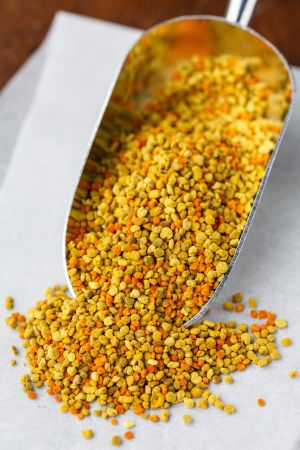
Carbohydrates: 46.77 g
Fibres: 14.4 g
Vitamins:
Vitamin B1: 1.01 mg
Vitamin B2: 0.86 mg
Vitamin B3: 7.1 mg
Vitamin B5:0.9 mg
Vitamin B6: 0.30 mg
Vitamin B9: 844 mg (!)
Vitamin C: 29.8 mg
Vitamin E: 11.8 mg
Minerals:
Copper, Cu: 0.85 mg
Magnesium, Mg: 71.4 mg
Phosphor, P: 566 mg
Zinc, Zn: 4.7 mg
Potassium, K: 484 mg
Sodium, Na: 31 mg
Polyphenols: 2086 (very high!)
ORAC: 406 mmoles/g
Flavonoids:
Kaempferol-3.0- glucos.: 575
Isorhamnetine-3.0- glucos.: 158
Rutine: 335
Luteoline-7-glucoside: 6.6
Phytosterols: 191
Essential Amino acids:
Threonine: 670 mg
Valine:790 mg
Methionine: 420 mg
Isoleucine: 640 mg
Leucine: 1130 mg
Phenylalanine: 770 mg
Lysine: 1020 mg
Tryptophane: 160 mg
Totals: 5710
Cystine: 170
Health benefits of willow bee pollen
Improves blood circulation
Other bee pollen types useful for this: cherry, horse chestnut, and sweet chestnut. (according to CAILLAS, A, 1975 and CHAUVIN, R, 1987)
General tonifier
Due to its high nutritional composition, willow bee pollen makes a good supplement to fortify the entire organism, help children grow, and support prolonged physical activity.
Protects against prostate cancer.
Willow bee pollen belongs to a group called beta-carotene, which is involved in antiprostatis activity. The antiprostatitis and anti-prostate cancer is evidenced for lycopene. A drop of PSA, an indicator of prostatitis and prostate cancer has been evidenced by Cistus and willow pollen, both pollen rich in carotenes, but not by chestnut pollen, which has a relatively low beta-carotene content. Beta carototene decreases the risk for some prostate carcinoma, as it was shown ever since 1999 by COOK, N et al. in their study “Beta-carotene supplementation for patients with low baseline levels and decreased risks of total and prostate carcinoma”.
How to take it
Bee pollen is especially recommended as a superfood added to your morning smoothies. But you can also sprinkle it on your yogurt, spreads or cereals. Mix it with honey, or just dilute the grains in other liquid at room temperature.
Some producers recommend taking it with a piece of fruit, as the fruit fibers (hemicellulose fibers) reinforce the activity of the pollen.
It is always good to start with a small quantity and increase it over time. An adult should start with half a teaspoon and children with 3 grains. Every day, add a few grains (only 2 for children) until you reach a tablespoon for adults and half a teaspoon for children.
Where can we buy willow bee pollen from?
• Amaon.co.uk offers fresh frozen willow bee pollen of good quality. The producer recommends keeping the packages in the freezer for a maximum of 1 year. For consumption, the pollen can also be kept in the refrigerator for a maximum of 6 days. Unfreeze only the dose you need for 6 days and keep the rest in the freezer.
The producer also sells bee pollen from Rock Rose and Heather.
• 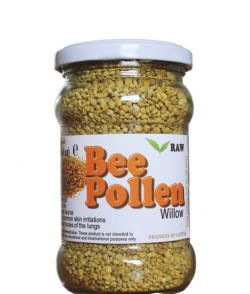
It can be stored at room temperature for 12 months.
The medicinal properties of willow
The leaves and bark of the willow tree have been used since antiquity, as it is mentioned in ancient texts from Assyria, Sumer, Egyp and Greece, as a remedy for aches and fever. Native Americans also use it as a staple of their medical treatments.
The active extract of the bark, Salicin is metabolized into salicylic acid in the human body.
A French pharmacist isolated this salicin in 1828 and in 1897, Felix Hoffmann created a synthetically altered version of salicin that caused less digestive upset than pure salicylic acid. The new drug, now acetylsalicylic acid, was named Aspirin.
These days, people are coming back to “all natural” and prefer the bark or the leaves to synthetic aspirin. They say the active ingredient in willow bark is, indeed, salicin, but the accompanying flavonoids and plant particles might be part of what make willow bark effective. That’s why they prefer to chew the raw bark. Or to make teas.
But this should also be approached carefully. There are 4 types of willows, and they contain different amounts of salicin. The branches should be of 2 to 3 year-old trees; not all bark is good; and so on. I have found a very good article on how to harvest and make tea from this bark.
Warning!
Be careful with the dosage. If it’s too concentrated, it can cause stomach bleeding. It can also interfere with certain medications, like blood thinners and beta-blockers.
Children and adolescents up to the age of 16 are generally discouraged from taking willow bark for any reason. This is because of the risk of Reye’s syndrome, a rare condition that causes brain and liver damage. The same restriction applies to pregnant, breast-feeding women, and people with gastric ulcers.
If taken in high quantities, all these warnings apply to willow bee pollen as well.
![]()
In the past, poor people often ate willow catkins that had been previously cooked to form a mash.
Thank the bee!
When you take a teaspoon of pollen, be aware that a bee has to work eight hours per day for a whole month to gather that spoon. That teaspoon contains over 2.5 billion grains of flower pollen!
Say thank you before you throw it in your smoothie or swallow it directly.
*********************************************
Resources:
http://www.healthline.com/health/willow-bark-natures-aspirin#benefits4
https://en.wikipedia.org/wiki/Willow
https://www.pollen.com/research/genus/salix
Stefan Bogdanov, Bee Product Science, April 2016


